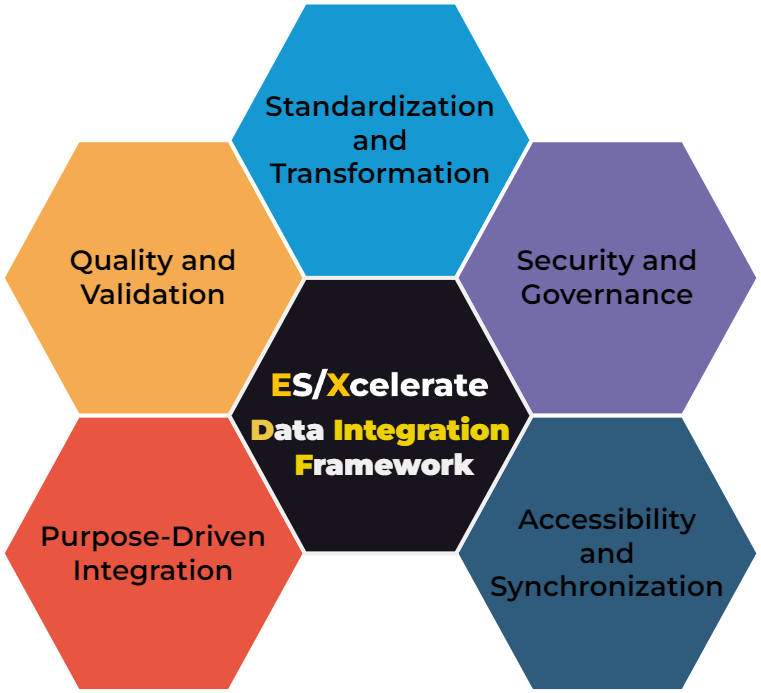Data integration is a crucial component of data engineering and data architecture, as it enables the transformation, enrichment, and consolidation of data from different sources and domains. However, data integration is not a one-size-fits-all solution, and it requires careful planning, design, and implementation to achieve the desired outcomes. That is why having an overarching architecture blueprint and framework like ES/Xcelerate Data & AI is essential for guiding the data integration process and ensuring its quality, security, and usability.
We will introduce the ES/Xcelerate Data & AI Integration Framework, a comprehensive and flexible framework for data integration that is based on five key principles: purpose-driven integration, data quality and validation, data standardization and transformation, data security and governance, and data accessibility and synchronization. These principles cover the main aspects and challenges of data integration, and provide a clear and consistent approach for integrating data across different scenarios and use cases.
The framework is designed to address the problem of data silos, fragmentation, and inconsistency that often plague data-driven organizations. Data silos are isolated and disconnected data sources that hinder the flow and sharing of information, and lead to inefficiencies, errors, and missed opportunities. Data fragmentation and inconsistency are the result of having data in different formats, structures, and levels of quality, which make it difficult to integrate and analyze the data effectively.
The scope of the framework is to provide a holistic and end-to-end solution for data integration, from data ingestion and extraction, to data cleansing and transformation, to data loading and delivery. The framework also incorporates best practices and standards for data integration, such as metadata management, data lineage, data catalog, data quality monitoring, and data security policies.
The ES/Xcelerate Data & AI Integration Framework is not a rigid or prescriptive framework, but rather a flexible and adaptable one that can be tailored to the specific needs and goals of each data integration project. The framework provides a set of tools and methods for assessing the maturity, risks, effectiveness, applicability, and alignment of the data integration process, and for measuring and improving its performance and outcomes. The framework also helps to ensure that the data integration process is aligned with the business goals and objectives, and that it supports the data-driven excellence and innovation of the organization.

© Nilay Parikh. All rights reserved. No warranty or liability implied.
In the following sections, we will explain each of the five principles of the ES/Xcelerate Data & AI Integration Framework in more detail, and provide examples and guidelines for applying them in practice. We will also show how the framework can help you to build mature, robust, and scalable data integration solutions and designs that can handle the complexity and diversity of data in the modern data landscape.
| Principle | Description |
| Purpose-driven integration | Data sources should undergo proper scrutiny before combining with the architecture, and only the necessary and relevant data should be integrated. |
| Quality and Validation | Data integration should ensure the accuracy, consistency, and reliability of the data, and implement processes to check for errors, anomalies, and integrity issues. |
| Standardization and Transformation | Data integration should convert and structure the data into a common format that ensures compatibility, alignment, and enrichment. |
| Security and Governance | Data integration should protect the data from unauthorized access, misuse, or loss, and adhere to the policies and regulations that govern the data. |
| Accessibility and Synchronization | Data integration should make the data available for analysis and decision making, and keep the data up to date over time, whether via periodic updates or real-time synchronization. |

Executive layer, providing succinct architectural insights through graphical representations and value-driven roadmaps. Align organizational data strategies with business goals, offering transparent views of budgetary, risk, and capability trade-offs.

Design layer for comprehensive architectural principles, design patterns, and technical recommendations. Tailored for architects and engineers, it guides through modern best practices, balancing quality, cost, and agility for robust implementations.

Data governance teams find their compass in the Controls layer, offering predefined audit controls, risk indicators, and capability maturity blueprints. Quantify operational metrics, ensuring a rigorous approach to quality, compliance, and usage across data processes.
License
This work (ES/Xcelerate Framework) by Nilay Parikh is licensed under CC BY 4.0 or view a human-readable summary.
If the above licenses do not suit your needs, please contact us at [email protected] to discuss your terms. We also offer more flexible commercial license that do not require attribution. The different licensing approaches reflect the intellectual property and commercial considerations associated with various framework elements while still promoting access.
Disclaimer
The views expressed on this site are personal opinions only and have no affiliation. See full disclaimer, terms & conditions, and privacy policy. No obligations assumed.
